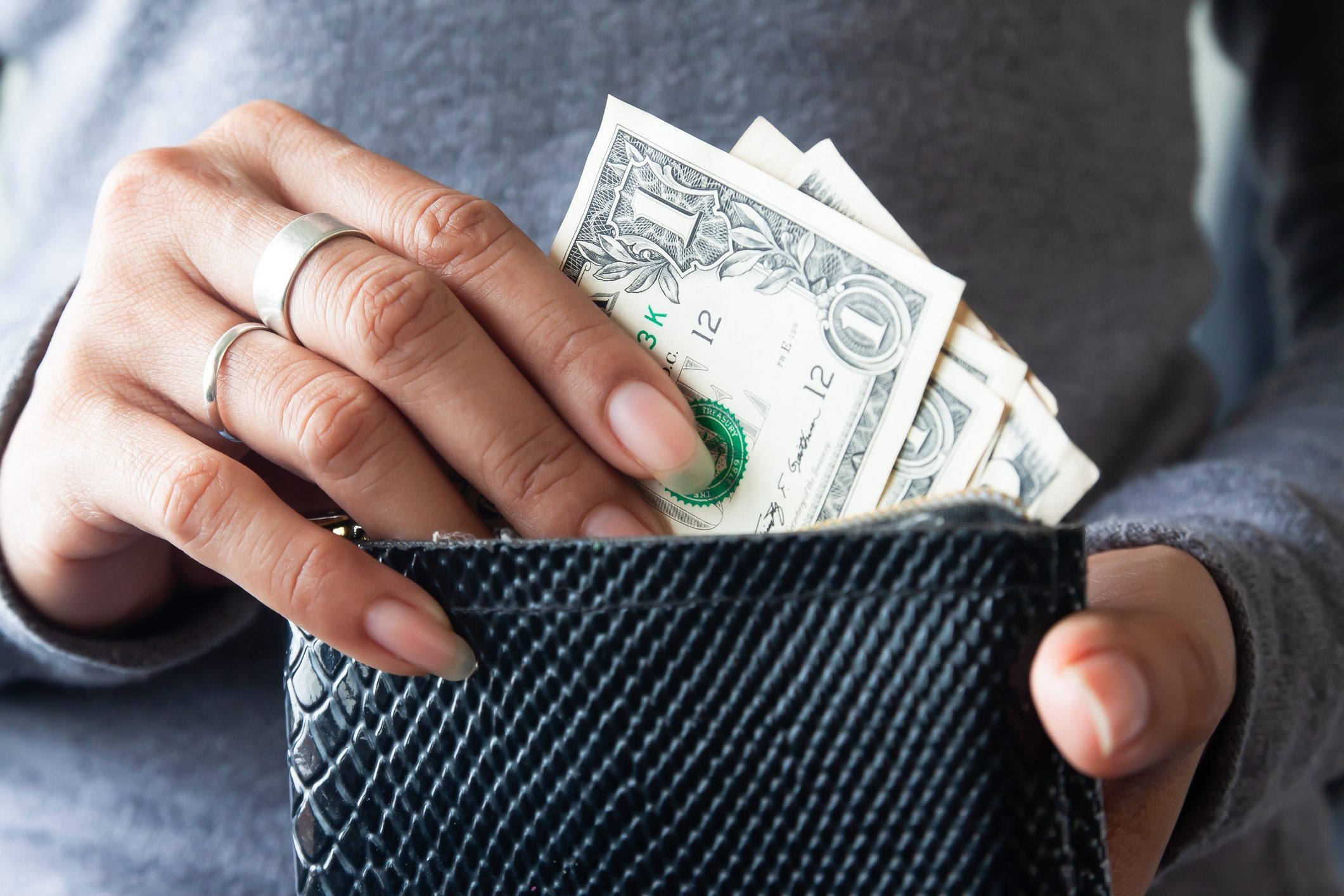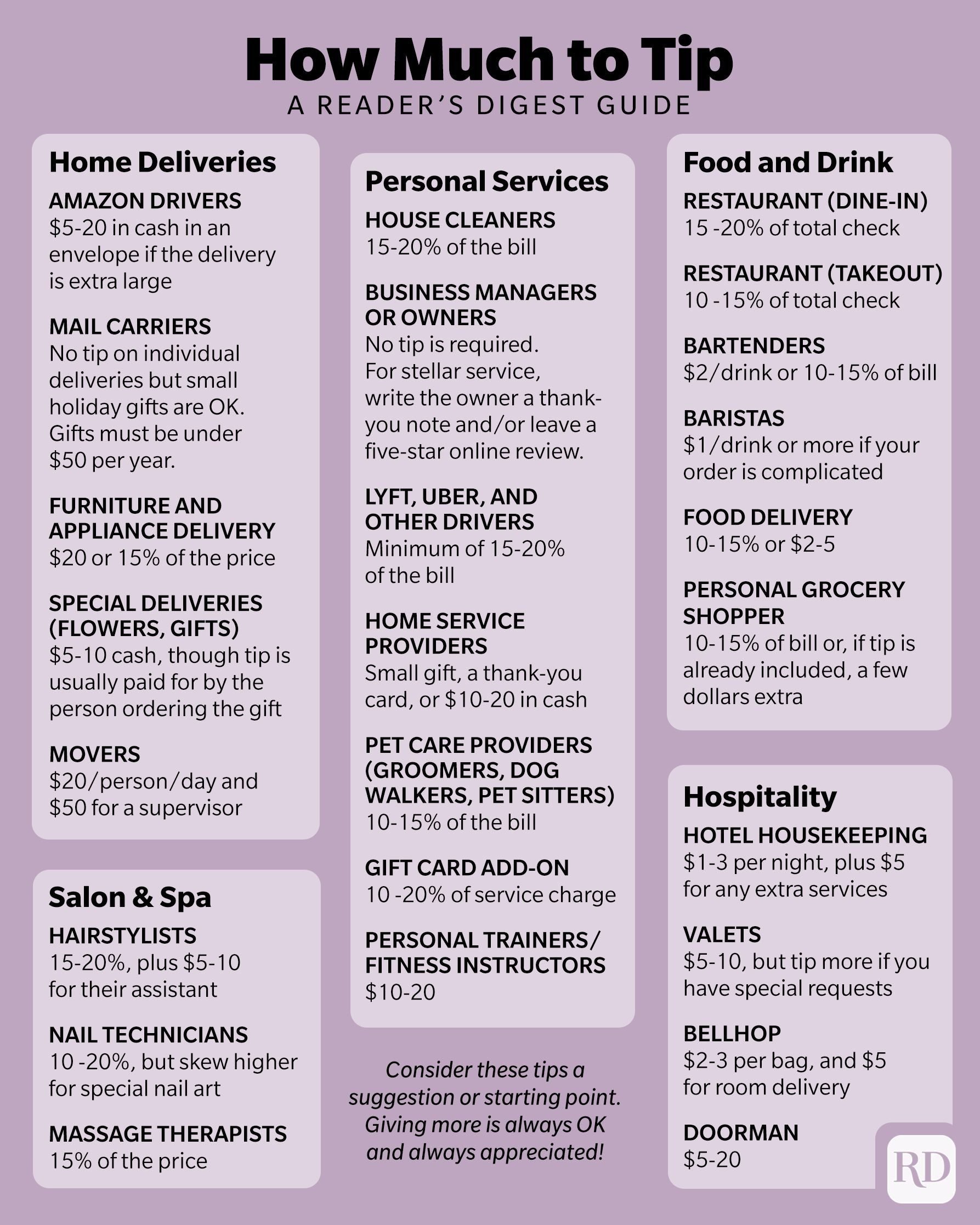The pandemic changed tipping etiquette. Here's what you need to know about when, what and how to tip now.

The New Tipping Etiquette: How Much to Tip in Every Situation

Knowing how much to tip has always been a little stressful—there are no set rules, so you’re left guessing how to convert service quality into cash—but the COVID-19 pandemic has only increased the confusion. Many workers who normally survive on tips, like waitstaff, hotel clerks and bartenders, lost this large part of their income when they no longer served customers in person, says Toni Dupree, a professional etiquette coach and author of a book and magazine column on etiquette rules.
But while tipping for in-person services stopped during the height of the pandemic, other types of services exploded. Suddenly things like food and package delivery and grocery pickup were considered safety essentials. Places that had never asked for a gratuity before, like fast-food restaurants, were now asking for tips. Newer service jobs became popular, like concierge health care, where doctors and nurses come to your home to do exams.
Do all these new services require a tip? Should the tip be bigger since these essential workers were working during a pandemic? Should tips depend on how risky the job is? And let’s not forget about the hit to most of our wallets. Money has been getting tighter for many people, particularly those who lost their jobs. Should folks on a reduced income still be expected to tip?
We’re here to answer all those questions and more so you know just how much to give in thanks for services rendered.
Old etiquette rules no longer apply
When the pandemic finally makes its exit, it’ll leave behind a handful of etiquette changes. The rules about whom, how, when and how much you should tip have changed, says Lisa Grotts, a certified etiquette professional, author of several books on etiquette and the former director of protocol for the city and county of San Francisco—a job where she oversaw national and diplomatic etiquette protocols, including tipping.
Here’s what has changed:
-
Whom you should tip. There are more types of service workers that should be tipped.
-
Amount of the tip. Many people are giving far more generous tips.
-
The type of tip given. In addition to cash, more people are “tipping” with gift baskets, prepackaged foods, thank-you notes and gift cards.
-
The situations in which we tip. Food-service tips moved beyond gratuities for waitstaff and now include tips on pickup and virtual orders or tips for the restaurant owner. New tipping situations have become common.
-
The tipping method. Many service people now prefer virtual tipping through Venmo, PayPal, Square, and other electronic apps that allow you to transfer money to someone personally and immediately.
-
What businesses do with the tips. More businesses are asking for tips, and it has become more common for tips to be divided between all the workers at an establishment, including those not directly interacting with customers.
How much to tip in a post-pandemic world
We’ve compiled the best tips on tipping in the United States from our experienced etiquette experts. Here’s the lowdown on whom, when, and how much you ought to tip.

Food and drink
Restaurant takeout: When the pandemic hit, a lot of in-person restaurants sold takeout only, prompting people to wonder: Do you tip for takeout? The answer is yes. You should tip restaurant workers for all orders, including takeout and delivery. Tip in high-end as well as casual restaurants.
Tip: 10 to 15 percent of the total check
In-person restaurant: Tip your waiter or waitress if you dine in but also tip anyone who assists you in getting your food, as waitstaff often do many jobs now. That’s just good dining etiquette.
Tip: 20 percent of the total check
Food delivery: Tipping is now expected for all types of food deliveries, including DoorDash and UberEats. Most delivery drivers prefer to be tipped through the app, and this is often done when the order is placed, before the delivery happens. So, how much should you tip for pizza delivery next time you get a craving for a warm, cheesy pie? It depends on your bill’s total, but the below advice is a good rule to follow. Here are more great food delivery services.
Tip: 15 percent or $2 to $5, but consider increasing the amount if the weather is bad, if you live far away or if your order is large.
Personal grocery shoppers: The pandemic popularized grocery shopping services like Instacart, where you place an order online or through an app and then someone else does the shopping for you. Tip your shopper, even if you go to the store and pick up the delivery yourself. Tips in the app are preferred, but cash is acceptable.
Tip: 10 to 15 percent of the bill or, if tip is already included, a few dollars extra
Bartenders: Consider tipping generously, as it is more common now for bartenders to have to split their tips with everyone working that shift.
Tip: $2 per drink or 10 to 15 percent of the bill
Baristas: Your spare change dropped in a jar on the counter used to be enough, but now tipping is expected.
Tip: $1 per drink or more if your order is complicated
Hospitality
Hotel housekeeping: Tip daily, leaving cash in an envelope marked for the housekeeper or with “hotel housekeeping” written on the front.
Tip: $1 to $3 per night, plus $5 for any extra services, like an emergency razor
Valets: Tip cash when you hand over the keys. How much to tip a valet depends on whether you have special requests; if you do, tip more.
Tip: $5 to $10
Doormen: Doormen do a lot more than simply hailing cabs these days, so take into account how much work they do for you. Also, take the weather into consideration.
Tip: $5 to $20
Bellhop: Tip per bag and a little extra if they take your luggage all the way to your room.
Tip: $2 to $3 per bag, and $5 for room delivery
Home deliveries
Amazon delivery drivers: Amazon drivers are allowed to accept tips, but it isn’t expected. Consider a tip if you have things delivered more than twice a week. Bottled water or juice and prepackaged snacks left on your porch is a nice gesture too.
Tip: $5 to $20 in cash in an envelope if the delivery is extra large
USPS drivers and mail carriers: The United States Postal Service has updated its rules about what employees can and cannot accept—gifts need to be under $50 per year. Here’s what you’re legally allowed to gift your mail carrier. There’s no limit on thank-you notes though!
Tip: No tip on individual deliveries but a small gift or cash at the holidays is always appreciated.
Furniture and appliance delivery people: The amount of the tip depends on the size of the package and what kind of work was done. For instance, tip more if they installed an appliance, put together furniture or removed old items for you.
Tip: $20 or 15 percent of the price
Special delivery people: Workers who deliver special-occasion items, like flower bouquets and gift baskets, are generally tipped by the person who ordered the gift, but it’s kind to consider offering them a tip as well.
Tip: $5 to $10 cash
Movers: Even if your company is paying for your move to a new house, you should tip movers. It’s also nice to provide cold drinks and food for movers.
Tip: $20 per person per day and $50 for a supervisor
Salon and spa services
Hairstylists and barbers: Tip your stylist, barber, and their assistants. One of the biggest salon etiquette mistakes you can make is walking out without handing your stylist and the assistant who washed your hair some money in thanks.
Tip: 15 to 20 percent, plus $5 to $10 for the assistant
Nail technicians: Tip for all services, including manicures, pedicures, foot massages and polish changes. How much to tip for a pedicure, manicure and the like depends on how much work is done.
Tip: 10 to 20 percent, but skew higher if you have special nail art done
Massage therapists: How much to tip a massage therapist will depend on the overall cost of your massage. But keep in mind that extra cleaning protocols have added more work to a typical massage and consider tipping a little more generously.
Tip: 15 percent of the cost or $20
Personal services
House cleaners: You should certainly tip house cleaners during the holidays or for extra work, but many people are now adding a small tip for each cleaning done well.
Tip: 15 to 20 percent of the bill
Business managers or owners: Some people have recommended tipping the salon owner in addition to the stylist or manicurist. But it’s more common now for small business owners to require any tips earned by individual employees to be shared with the rest of the staff, so tipping the boss separately is unnecessary.
Tip: No tip is required, but if service is spectacular, consider writing the owner a thank-you note and leaving a five-star online review.
Lyft, Uber and other drivers: Do you tip Uber drivers and other folks who cart you from here to there? You betcha. You can still tip cash to the driver at the end of the ride or tip electronically through the app (it often will suggest an amount). Tips are generally more generous now than they were previously.
Tip: A minimum of 15 to 20 percent of the bill
Home service providers: Plumbers, painters, HVAC specialists, carpet cleaners, appliance repair people, handymen and other people who do odd jobs in your home generally include everything in the final price, but you can tip if you feel like the service was extraordinary.
Tip: A small gift, a thank-you card, or $10 to $20 in cash
Pet care providers: How much to tip a dog groomer, dog walker or pet sitter depends on the cost of the service, but etiquette rules dictate you tip something. It isn’t necessary to tip veterinarians or vet techs, however.
Tip: 10 to 15 percent of the bill
Personal trainers and fitness instructors: No tips are necessary for a regular training session or class, but consider tipping at the end of a package of sessions, like eight weeks. Group fitness instructors do not expect tips, but the occasional gift is always appreciated.
Tip: $10 to $20
Gift cards: When you purchase a gift card in the amount of the service—say, when buying a massage or restaurant dinner for a friend—be sure to add the tip amount onto the gift card. This makes it easy for the person using the gift card to pay for the service and the tip. Without gratuity included, many people forget to tip on gifts.
Tip: 10 to 20 percent of the service charge
When in doubt, tip
There are many other situations in which tipping may be appropriate, and if you’re in doubt, offer a tip, says Dupree. “One of my favorite quotes, by George Eliot, says, ‘What do we live for if not to make the world less difficult for each other?’ Tipping well is one way to make things a little easier for someone else.”
When to skip the tip
While service workers appreciate—and often rely on—tips, not everyone should get a monetary bonus. In addition to USPS drivers, many government workers aren’t able to accept tips. You don’t need to tip teachers, health care providers or professionals like lawyers and accountants. But you can still give them gifts, like these best gifts for nurses.
Other tips on tipping:
-
Before you tip, check if gratuity has already been added to your bill.
-
Calculate how much to tip based on original prices, even if your order has a discount.
-
If you want to become the beloved regular at your bar, tip bartenders generously (50 percent). For the same title at a coffee joint, put $5 straight into the tip jar. Being friendly and starting conversations will also get you remembered, and getting on the employees’ good side could get you a free drink in the future.
-
Don’t leave your tip out in the open. Give it to the server directly, put it in the holder the check came in or use a credit card.
-
Don’t be shy about tipping more if you receive excellent service.
-
If people can’t or won’t accept tips, still give them a handshake and a sincere “Thank you.”
- If you’re traveling overseas, read up on tipping guidelines. Tipping etiquette around the world differs from etiquette in the United States.
Sources:
- Toni Dupree, certified etiquette coach, CEO of Etiquette & Style by Dupree, author of Whose Fork is it Anyway?, and writer of an etiquette column for MVMNT magazine
- Lisa Grotts, a certified etiquette professional, founder of Golden Rules Gal, former director of protocol for the city and county of San Francisco, and author of several books on etiquette
- Maryanne Parker, owner of Manor of Manners
- Jodi R.R. Smith, president of Mannersmith Etiquette Consulting
- April Masini, relationship and etiquette expert



















